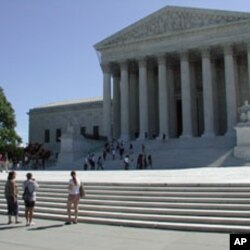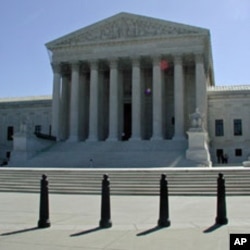This week, the U.S. Supreme Court closed its front entrance because of security concerns. Visitors and litigants will now have to go through side entrances with heightened security. The move is drawing criticism from justices, historians and the public.
Listen to an interview with University of Virginia architecture professor Richard Guy Wilson:
The U.S. Supreme Court building sits on First Street across from the U.S. Capitol and near the Library of Congress. Its design is reminiscent of a Roman temple with a colonnade across the front.
Atop the Corinthian columns along the west front of the building are the words "Equal Justice Under Law" carved into the Vermont marble. The bas-relief sculptures depict figures raised from a sunken background. The facade includes sculptures representing Order, Liberty Enthroned, and Authority. Liberty is the centerpiece of the group.
The building was designed by renowned architect Cass Gilbert and features a set of huge bronze doors. The doors have four, low-relief panels that illustrate key developments in the Western legal tradition. Gilbert and John Donnelley, Sr. designed the doors to signify the importance of the proceedings taking place at the Court.
Litigants and spectators alike including those from several high-profile cases - Brown vs. the Board of Education - a key case in the U.S. Civil Rights movement - and Roe vs. Wade, the landmark case on abortion - have passed through the doors into the Court chamber.
But now that is impossible.
In keeping with security recommendations, visitors, litigants and spectators must now go to the side entrances of the iconic building. They may leave the Court through the bronze doors, but they cannot enter that way.
On a bright, Spring day in Washington, several tour groups are gathered outside the Court. One of those leading a tour of school children is Kent Smiema of Minneapolis, Minnesota, who is a sign language interpreter for the Close Up foundation. Mika Bennett-Fraychineaud from Arizona, a member of the group says closing the doors sends the wrong message.
"The front door of the Supreme Court should never be closed, let alone closed permanently," said Smiema. "We need as American citizens to be able to know what is going on in our government and the decisions the Supreme Court is making."
University of Virginia Commonwealth Professor of Architectural history Richard Guy Wilson says that the intention of the entrance was to make a statement about the importance of law in the United States. But Wilson says that closing the bronze doors is a bad idea.
"It is, I think, very much the whole idea that we are all equal and we all stand together in front of the law," he said. "But what we have been increasingly seeing is this - and I do understand security, but there are other ways of handling security than putting you through the basement. We used to enter a building in a sense like we were all part of royalty. And now we enter like we are a bunch of rats, in the basement."
Justice Stephen G. Breyer wrote in a statement joined by Justice Ruth Bader Ginsberg that the significance of the front entrance "extends beyond its design and function." Justice Stephens said that the entrance has been used multiple times to represent the ideal that "anyone in this country may obtain meaningful justice through application to this Court."
The Justice said he finds the move "dispiriting" while acknowledging the need for increased security in the wake of terrorist attacks. Justice Breyer wrote that he knows of no other Supreme Court in the world - including Israel's which faces security concerns as well - that has closed its front door.
The official statement from the Court - which couched the move as part of its ongoing modernization project - said the decision to close the entrance was made after security studies in 2001 and 2009.
Moving the entrances is intended to help reduce a threat from weapons, explosives, chemical weapons and biological attacks. Those visiting the court may still leave through the bronze doors, but - for now - going into the building that way is impossible.













